Let’s take a look at the origin of tech companies’ logos and how they evolved:
Adobe Systems
 In 1982, forty-something programmers John Warnock and Charles Geschke quit their work at Xerox to start a software company. They named it Adobe, after a creek that ran behind Warnock’s home. Their first focus was to create PostScript, a programming language used in desktop publishing.
In 1982, forty-something programmers John Warnock and Charles Geschke quit their work at Xerox to start a software company. They named it Adobe, after a creek that ran behind Warnock’s home. Their first focus was to create PostScript, a programming language used in desktop publishing. When Adobe was young, Warnock and Geschke did everything they could to save money. They asked family and friends to help out: Geschke’s 80-year-old father stained lumber for shelving, and Warnock’s wife Marva designed Adobe’s first logo.
Apple Inc.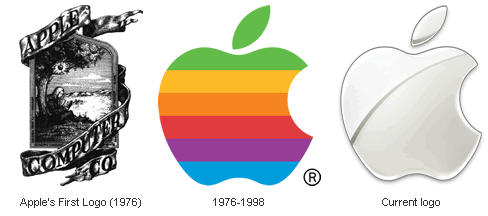 The first Apple logo was a complex picture of Isaac Newton sitting under an apple tree. The logo was inscribed: "Newton … A Mind Forever Voyaging Through Strange Seas of Thought … Alone." It was designed by Ronald Wayne, who along with Wozniak and Jobs, actually founded Apple Computer. In 1976, after only working for two weeks at Apple, Wayne relinquished his stock (10% of the company) for a one-time payment of $800 because he thought Apple was too risky! (Had he kept it, Wayne’s stock would be worth billions!)
The first Apple logo was a complex picture of Isaac Newton sitting under an apple tree. The logo was inscribed: "Newton … A Mind Forever Voyaging Through Strange Seas of Thought … Alone." It was designed by Ronald Wayne, who along with Wozniak and Jobs, actually founded Apple Computer. In 1976, after only working for two weeks at Apple, Wayne relinquished his stock (10% of the company) for a one-time payment of $800 because he thought Apple was too risky! (Had he kept it, Wayne’s stock would be worth billions!)Canon
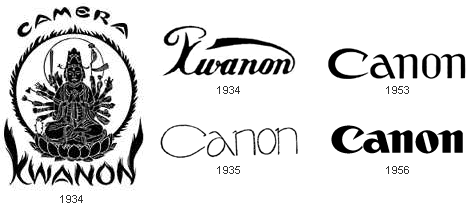 In 1930, Goro Yoshida and his brother-in-law Saburo Uchida created Precision Optical Instruments Laboratory in Japan. Four years later, they created their first camera, called the Kwanon. It was named after the Kwanon, Buddhist Bodhisattva of Mercy. The logo included an image of Kwanon with 1,000 arms and flames.
In 1930, Goro Yoshida and his brother-in-law Saburo Uchida created Precision Optical Instruments Laboratory in Japan. Four years later, they created their first camera, called the Kwanon. It was named after the Kwanon, Buddhist Bodhisattva of Mercy. The logo included an image of Kwanon with 1,000 arms and flames. Coolness of logo notwithstanding, the company registered the differently spelled word "Canon" as a trademark because it sounded similar to Kwanon while implying precision, a characteristic the company would like to be known and associated with.
Google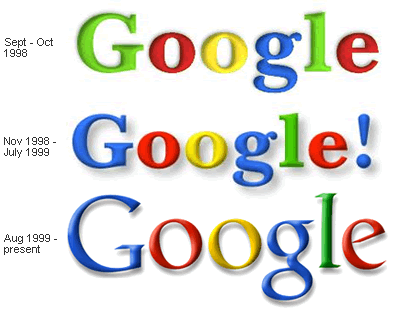 In 1996, Stanford University computer science graduate students Larry Page and Sergey Brin built a search engine that would later become Google. That search engine was called BackRub, named for its ability to analyze "back links" to determine relevance of a particular website. Later, the two renamed their search engine Google, a play on the word Googol (meaning 1 followed by 100 zeros).
In 1996, Stanford University computer science graduate students Larry Page and Sergey Brin built a search engine that would later become Google. That search engine was called BackRub, named for its ability to analyze "back links" to determine relevance of a particular website. Later, the two renamed their search engine Google, a play on the word Googol (meaning 1 followed by 100 zeros).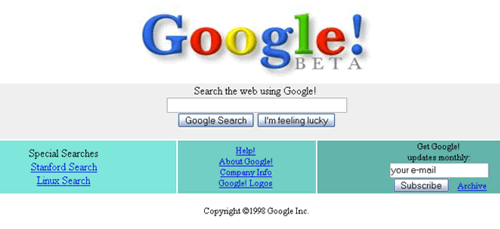 Two years later, Larry and Sergey went to Internet portals (who dominated the web back then) but couldn’t get anyone interested in their technology. In 1998, they started Google, Inc. in a friend’s garage, and the rest is history.
Two years later, Larry and Sergey went to Internet portals (who dominated the web back then) but couldn’t get anyone interested in their technology. In 1998, they started Google, Inc. in a friend’s garage, and the rest is history. Google’s first logo was created by Sergey Brin, after he taught himself to use the free graphic software GIMP. Later, an exclamation mark mimicking the Yahoo! logo was added. In 1999, Stanford’s Consultant Art Professor Ruth Kedar designed the Google logo that the company uses today.
 To mark holidays, birthdays of famous people and major events, Google uses specially drawn logos known as the Google Doodles. The very first Google Doodle was a reference to the Burning Man Festival in 1999. Larry and Sergey put a little stick figure on the home page to let people know why no one was in the office in case the website crashed! Now, Google Doodles are regularly drawn by Dennis Hwang.
To mark holidays, birthdays of famous people and major events, Google uses specially drawn logos known as the Google Doodles. The very first Google Doodle was a reference to the Burning Man Festival in 1999. Larry and Sergey put a little stick figure on the home page to let people know why no one was in the office in case the website crashed! Now, Google Doodles are regularly drawn by Dennis Hwang.
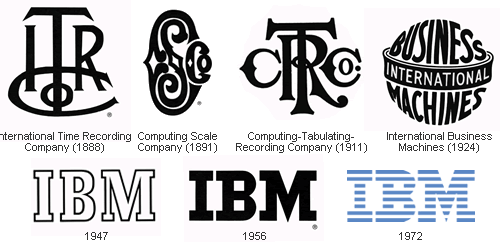 In 1911, the International Time Recording Company (ITR, est. 1888) and the Computing Scale Company (CSC, est. 1891) merged to form the Computing-Tabulating-Recording Company (CTR, see where IBM gets its penchant for three letter acronym?). In 1924, the company adopted the name International Business Machines Corporation and a new modern-looking logo. It made employee time-keeping systems, weighing scales, meat slicers, and punched-card tabulators.
In 1911, the International Time Recording Company (ITR, est. 1888) and the Computing Scale Company (CSC, est. 1891) merged to form the Computing-Tabulating-Recording Company (CTR, see where IBM gets its penchant for three letter acronym?). In 1924, the company adopted the name International Business Machines Corporation and a new modern-looking logo. It made employee time-keeping systems, weighing scales, meat slicers, and punched-card tabulators. In the late 1940s, IBM began a difficult transition of punched-card tabulating to computers, led by its CEO Thomas J. Watson. To signify this radical change, in 1947, IBM changed its logo for the first time in over two decades: a simple typeface logo.
In 1956, with the leadership of the company being passed down to Watson’s son, Paul Rand changed IBM’s logo to have "a more solid, grounded and balanced appearance" and at the same time he made the change subtle enough to communicate that there’s continuity in the passing of the baton of leadership from father to son.
IBM logo’s last big change – which wasn’t all that big – was in 1972, when Paul Rand replaced the solid letters with horizontal stripes to suggest "speed and dynamism."
LG Electronics
 LG began its life as two companies: Lucky (or Lak Hui) Chemical Industrial (est. 1947), which made cosmetics and GoldStar (est. 1958), a radio manufacturing plant. Lucky Chemical became famous in Korea for creating the Lucky Cream, with a container bearing the image of the Hollywood starlet Deanna Durbin. GoldStar evolved from manufacturing only radios to making all sorts of electronics and household appliances.
LG began its life as two companies: Lucky (or Lak Hui) Chemical Industrial (est. 1947), which made cosmetics and GoldStar (est. 1958), a radio manufacturing plant. Lucky Chemical became famous in Korea for creating the Lucky Cream, with a container bearing the image of the Hollywood starlet Deanna Durbin. GoldStar evolved from manufacturing only radios to making all sorts of electronics and household appliances.
In 1995, Lucky Goldstar changed its name to LG Electronics (yes, a backronym apparently not). Actually, LG is a chaebol (a South Korean conglomerate), so there’s a whole range of LG companies that also changed their names, such as LG Chemicals, LT Telecom, and even a baseball team called the LG Twins. These companies all adopted the "Life is Good" tagline you often see alongside its logo.
Interestingly, LG denies that their name now stands for Lucky Goldstar… or any other words. They’re just "LG."
Microsoft
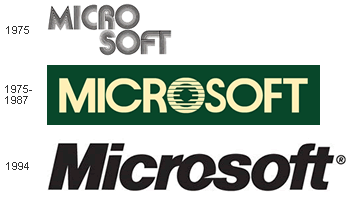 In 1975, Paul Allen (who then was working at Honeywell) and his friend Bill Gates (then a sophomore at Harvard University) saw a new Altair 8800 of Micro Instrumentation and Telemetry Systems or MITS. It was the first mini personal computer available commercially.
In 1975, Paul Allen (who then was working at Honeywell) and his friend Bill Gates (then a sophomore at Harvard University) saw a new Altair 8800 of Micro Instrumentation and Telemetry Systems or MITS. It was the first mini personal computer available commercially.
Allen and Gates decided to port the computer language BASIC for the computer (they did this in 24 hours!), making it the first computer language written for a personal computer. They approached MITS and ended up licensing BASIC to the company. Shortly afterwards, Allen and Gates named their partnership "Micro-soft" (within the year, they dropped the hyphen). In 1977, Microsoft became an official company with Allen and Gates first sharing the title general partners.
On to the logo history:
In 1982, Microsoft announced a new logo, complete with the distinctive "O" that employees dubbed the "Blibbet." When the logo was changed in 1987, Microsoft employee Larry Osterman launched a "Save the Blibbet" campaign but to no avail. Supposedly, way back when, Microsoft cafeteria served "Blibbet Burger," a double cheeseburger with bacon.
In 1987, Scott Baker designed the current, so-called "Pac-Man Logo" for Microsoft. The new logo has a slash on the ‘O’ that made it look like Pac-Man, hence the name. In 1994 Microsoft introduced a new tagline Where do you want to go today?, as part of a $100 million advertising campaign. Needless to say, it was widely mocked.
In 1996, perhaps tired of being the butt of jokes like "what kind of error messages would you like today?", Microsoft dropped the slogan. Later, it tried on new taglines like "Making It Easier", "Start Something", "People Ready" and "Open Up Your Digital Life" before settling on the current "Your potential. Our passion."
Motorola
 Motorola, then Galvin Manufacturing Corporation, was started in 1928 by Paul Galvin. In the 1930s, Galvin started manufacturing car radios, so he created the name ‘Motorola’ which was simply the combination of the word ‘motor’ and the then-popular suffix ‘ola.’ The company switched its name in 1947 to Motorola Inc. In the 1980s, the company started making cellular phones commercially.
Motorola, then Galvin Manufacturing Corporation, was started in 1928 by Paul Galvin. In the 1930s, Galvin started manufacturing car radios, so he created the name ‘Motorola’ which was simply the combination of the word ‘motor’ and the then-popular suffix ‘ola.’ The company switched its name in 1947 to Motorola Inc. In the 1980s, the company started making cellular phones commercially.
The stylized "M" insignia (the company called it "emsignia") was designed in 1955. A company leader said that "the two aspiring triangle peaks arching into an abstracted ‘M’ typified the progressive leadership-minded outlook of the company." (I’m serious, look up the logo-speak here: Motorola History)
Mozilla Firefox
 In 2002, Dave Hyatt and Blake Ross created an open-source web browser that ultimately became Mozilla Firefox. At first, it was titled Phoenix, but this name ran into trademark issues and was changed to Firebird. Again, the replacement name ran into problem because of an existing software. Third time’s the charm: the web browser was re-named Mozilla Firefox.
In 2002, Dave Hyatt and Blake Ross created an open-source web browser that ultimately became Mozilla Firefox. At first, it was titled Phoenix, but this name ran into trademark issues and was changed to Firebird. Again, the replacement name ran into problem because of an existing software. Third time’s the charm: the web browser was re-named Mozilla Firefox.
In 2003, professional interface designer Steven Garrity, wrote that the browser (and other software released by Mozilla) suffered from poor branding. Soon afterwards, Mozilla invited him to develop a new visual identity for Firefox, including the famous logo.
Update 2/7/08: I goofed on this one, guys: it was John Hicks of Hicksdesign that actually made the Firefox logo, designed from a concept from Daniel Burka and sketched by Stephen Desroches.
Nokia
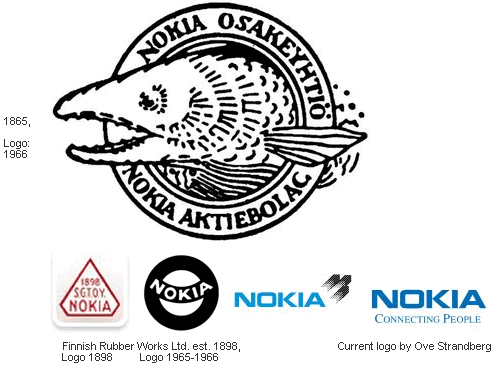 In 1865, Knut Fredrik Idestam established a wood-pulp mill in Tampere, south-western Finland. It took on the name Nokia after moving the mill to the banks of the Nokianvirta river in the town of Nokia. The word "Nokia" in Finnish, by the way, means a dark, furry animal we now call the Pine Marten weasel.
In 1865, Knut Fredrik Idestam established a wood-pulp mill in Tampere, south-western Finland. It took on the name Nokia after moving the mill to the banks of the Nokianvirta river in the town of Nokia. The word "Nokia" in Finnish, by the way, means a dark, furry animal we now call the Pine Marten weasel.
The modern company we know as the Nokia Corporation was actually a merger between Finnish Rubber Works (which also used a Nokia brand), the Nokia Wood Mill, and the Finnish Cable Works in 1967.
Before focusing on telecommunications and cell phones, Nokia produced paper products, bicycle and car tires, shoes, television, electricity generators, and so on.




2 reactions:
nice article.. keep going, mod!
wow! kwanon! LOL. It's kinda funny mod ;D
Post a Comment